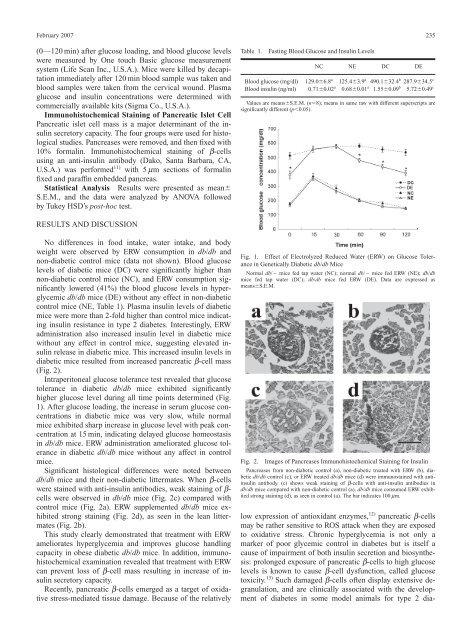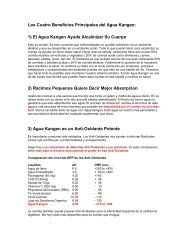ACID-ALKALINE BALANCE: ROLE IN CHRONIC ... - My Kangen Tools
ACID-ALKALINE BALANCE: ROLE IN CHRONIC ... - My Kangen Tools
ACID-ALKALINE BALANCE: ROLE IN CHRONIC ... - My Kangen Tools
Create successful ePaper yourself
Turn your PDF publications into a flip-book with our unique Google optimized e-Paper software.
February 2007 235<br />
(0—120 min) after glucose loading, and blood glucose levels<br />
were measured by One touch Basic glucose measurement<br />
system (Life Scan Inc., U.S.A.). Mice were killed by decapitation<br />
immediately after 120 min blood sample was taken and<br />
blood samples were taken from the cervical wound. Plasma<br />
glucose and insulin concentrations were determined with<br />
commercially available kits (Sigma Co., U.S.A.).<br />
Immunohistochemical Staining of Pancreatic Islet Cell<br />
Pancreatic islet cell mass is a major determinant of the insulin<br />
secretory capacity. The four groups were used for histological<br />
studies. Pancreases were removed, and then fixed with<br />
10% formalin. Immunohistochemical staining of b-cells<br />
using an anti-insulin antibody (Dako, Santa Barbara, CA,<br />
U.S.A.) was performed 11) with 5mm sections of formalin<br />
fixed and paraffin embedded pancreas.<br />
Statistical Analysis Results were presented as mean<br />
S.E.M., and the data were analyzed by ANOVA followed<br />
by Tukey HSD’s post-hoc test.<br />
Table 1.<br />
Fasting Blood Glucose and Insulin Levels<br />
NC NE DC DE<br />
Blood glucose (mg/dl) 129.06.8 a 125.43.9 a 490.132.4 b 287.934.5 c<br />
Blood insulin (ng/ml) 0.710.02 a 0.680.01 a 1.550.09 b 5.720.49 c<br />
Values are meansS.E.M. (n8); means in same raw with different superscripts are<br />
significantly different (p0.05).<br />
RESULTS AND DISCUSSION<br />
No differences in food intake, water intake, and body<br />
weight were observed by ERW consumption in db/db and<br />
non-diabetic control mice (data not shown). Blood glucose<br />
levels of diabetic mice (DC) were significantly higher than<br />
non-diabetic control mice (NC), and ERW consumption significantly<br />
lowered (41%) the blood glucose levels in hyperglycemic<br />
db/db mice (DE) without any effect in non-diabetic<br />
control mice (NE, Table 1). Plasma insulin levels of diabetic<br />
mice were more than 2-fold higher than control mice indicating<br />
insulin resistance in type 2 diabetes. Interestingly, ERW<br />
administration also increased insulin level in diabetic mice<br />
without any effect in control mice, suggesting elevated insulin<br />
release in diabetic mice. This increased insulin levels in<br />
diabetic mice resulted from increased pancreatic b-cell mass<br />
(Fig. 2).<br />
Intraperitoneal glucose tolerance test revealed that glucose<br />
tolerance in diabetic db/db mice exhibited significantly<br />
higher glucose level during all time points determined (Fig.<br />
1). After glucose loading, the increase in serum glucose concentrations<br />
in diabetic mice was very slow, while normal<br />
mice exhibited sharp increase in glucose level with peak concentration<br />
at 15 min, indicating delayed glucose homeostasis<br />
in db/db mice. ERW administration ameliorated glucose tolerance<br />
in diabetic db/db mice without any affect in control<br />
mice.<br />
Significant histological differences were noted between<br />
db/db mice and their non-diabetic littermates. When b-cells<br />
were stained with anti-insulin antibodies, weak staining of b-<br />
cells were observed in db/db mice (Fig. 2c) compared with<br />
control mice (Fig. 2a). ERW supplemented db/db mice exhibited<br />
strong staining (Fig. 2d), as seen in the lean littermates<br />
(Fig. 2b).<br />
This study clearly demonstrated that treatment with ERW<br />
ameliorates hyperglycemia and improves glucose handling<br />
capacity in obese diabetic db/db mice. In addition, immunohistochemical<br />
examination revealed that treatment with ERW<br />
can prevent loss of b-cell mass resulting in increase of insulin<br />
secretory capacity.<br />
Recently, pancreatic b-cells emerged as a target of oxidative<br />
stress-mediated tissue damage. Because of the relatively<br />
Fig. 1. Effect of Electrolyzed Reduced Water (ERW) on Glucose Tolerance<br />
in Genetically Diabetic db/db Mice<br />
Normal db/ mice fed tap water (NC); normal db/ mice fed ERW (NE); db/db<br />
mice fed tap water (DC); db/db mice fed ERW (DE). Data are expressed as<br />
meansS.E.M.<br />
Fig. 2.<br />
Images of Pancreases Immunohistochemical Staining for Insulin<br />
Pancreases from non-diabetic control (a), non-diabetic treated with ERW (b), diabetic<br />
db/db control (c), or ERW treated db/db mice (d) were immunostained with antiinsulin<br />
antibody. (c) shows weak staining of b-cells with anti-insulin antibodies in<br />
db/db mice compared with non-diabetic control (a). db/db mice consumed ERW exhibited<br />
strong staining (d), as seen in control (a). The bar indicates 100mm.<br />
low expression of antioxidant enzymes, 12) pancreatic b-cells<br />
may be rather sensitive to ROS attack when they are exposed<br />
to oxidative stress. Chronic hyperglycemia is not only a<br />
marker of poor glycemic control in diabetes but is itself a<br />
cause of impairment of both insulin secretion and biosynthesis:<br />
prolonged exposure of pancreatic b-cells to high glucose<br />
levels is known to cause b-cell dysfunction, called glucose<br />
toxicity. 13) Such damaged b-cells often display extensive degranulation,<br />
and are clinically associated with the development<br />
of diabetes in some model animals for type 2 dia-



